- Chinese officials have canceled the prayer festival of Dechen Shedrub at the famous Larung Gar institute in eastern Tibet, according to an official notice stating that there would be no more large religious gatherings held there. Religious teachings at Larung Gar, the world’s largest center of Tibetan Buddhist study and ethics, used to attract thousands of Chinese and Tibetan devotees as well as visitors from all over the world. The announcement of the ban states that Larung Gar is a place for religious study rather than religious practice, and that devotees from other areas are not welcome there.
- Security has been tightened and there is continuing distress among monks and nuns who were studying at Larung Gar, in Serthar (Chinese: Seda), Kardze (Chinese: Ganzi) Tibetan Autonomous Prefecture, Sichuan (the Tibetan area of Kham), in the aftermath of the imposition of direct Communist Party control on Larung Gar in 2017 and a wave of demolitions and expulsions. Many nuns displaced by the demolitions have not yet been re-housed, while monks returned to their villages are unable to rejoin monasteries and face major restrictions.
The sterner official tone of the announcement of the ban on the Dechen Shedrub prayer gathering, which was also cancelled last year and in 2016, appears to be a result of the appointment of 200 Party cadres and lay officials to key positions at the institute announced in August 2017, effectively taking over all management, finances, security, admissions, and even the choice of textbooks. This was preceded by demolitions of monks’ and nuns’ homes, and mass expulsions.
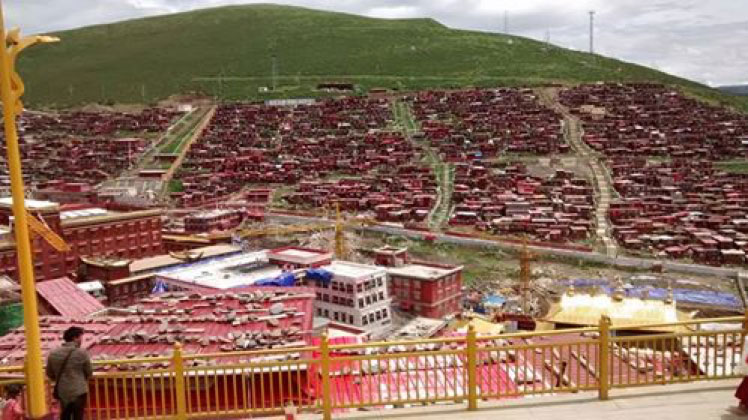
This view over Larung Gar shows where demolitions cut a swathe through the religious centre’s landscape, depicted from a new fenced viewing point.
Only monks already resident at Larung Gar are allowed to chant prayers at the time of the Dechen Shedrub prayer festival, according to the official notice, dated October 16 (2018).
The official notice also indicates that the purpose of Larung Gar is for religious study and education, and not religious practice, indicating a further tightening of control in an already oppressive climate against religion. A former monk from Tibet who saw the official notice circulating online said: “Last year, [the authorities] made various excuses to ban the prayer festival, saying for instance there was ongoing construction, that it would be detrimental to security, and other things. But the notice this year simply says that as Larung Gar is a ‘mid-level’ Nyingma institute, meaning that it was founded more recently than ancient institutions such as Samye monastery, no major religious gatherings will be held there. The official notice underlines the function of Larung Gar as religious education.”
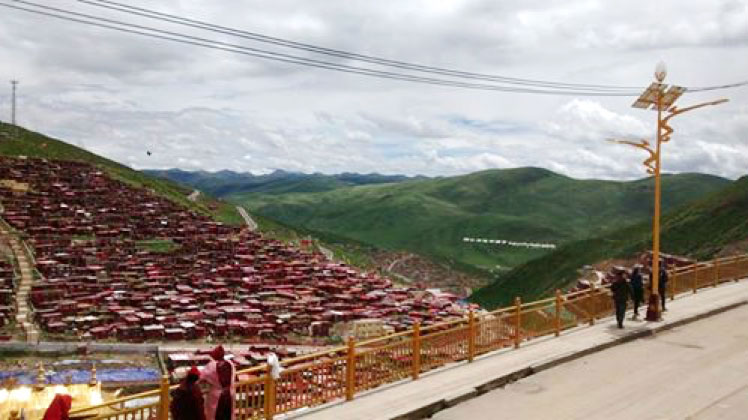
View over Larung Gar from new viewing point.
Last year the ban on the Dechen Shedrub festival coincided with tightened security and more police checkpoints at Larung Gar, and that appears to have intensified this year, according to reports received by ICT. Police are taking a stricter approach to any visitors to the area with access blocked to Larung Gar, Serthar town and other areas in Kardze (Chinese: Ganzi) to foreigners over the summer, and police checkpoints on the major roads to Larung Gar. Much of the construction work at Larung Gar had been carried out to attract tourists – with the development of tourism in the Serthar area being used as a tool to counter cultural resilience and monastic influence. But this year it appears that tourism is a distinctly lower priority to the authorities than ensuring Party control, preventing large gatherings of monks and nuns and imposing more stringent restrictions in the Chinese authorities’ stated aim of “Sinicizing” Tibetan Buddhism.[1]
Reports indicate an ever-present awareness among monks and nuns of police and security officials in civilian clothes, with one visitor saying that they saw a group of Chinese in civilian clothing in a bus outside the main temple – with a pile of handguns visible in the vehicle. The same visitor, who had travelled to Larung Gar in the past, said: “The place feels so different to before, so empty, not just of monks and nuns but also Tibetan pilgrims, there were even very few Chinese people there. It felt sad, broken.”
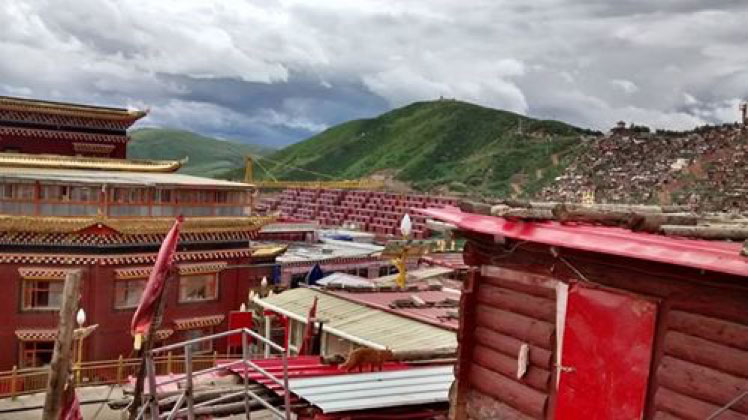
This image shows new housing at Larung Gar, close to the entrance.
The same visitor said that nuns being housed in temporary prefab style housing close to a new facility being built for them on the road to Larung Gar were not allowed even to go to the institute. Another 200 nuns were waiting in a tent settlement in the hillside to be housed. New housing for nuns was built at Larung Gar over the summer, but it was unclear who would be accommodated in these new buildings.
According to the same source, the story of one monk who was expelled from Larung Gar was typical; he had studied at Larung Gar since he had been a child, but after expulsion he was told to stay in his village and that he was not allowed to go and study anywhere else. He and other monks were told upon expulsion that they would be better off disrobing and not being monks at all. Others at Larung Gar told the visitor of monks and nuns from Lhasa who had been expelled being imprisoned as soon as they returned to the city.
The Dechen Shedrub religious festival falls this year on October 30 and lasts around eight days. Traditionally large numbers of devotees would gather together for the festival. It was cancelled in 2016 at the height of the demolitions, and once before in 2009, after the protests and crackdown in the area and across Tibet in 2008. Last year, the authorities promised that it would be permitted and monks had begun preparations, but it was suddenly cancelled before prayers were due to begin on November 6, 2017.[2]
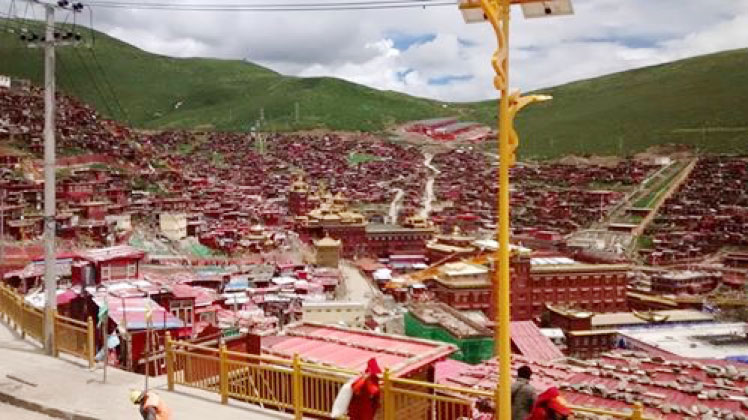
View across Larung Gar, summer, 2018, showing cleared spaces.
Recent images from the religious complex, which pioneered Buddhist revitalization in Tibetan areas from the 1980s onwards, attracting thousands of Chinese Buddhist practitioners as well as Tibetans, show three broad cleared strips in the settlement, constructed by demolishing homes at either side. Residential areas are being divided further into segments, and a tarmacked road has been built so that tourists can drive up to stay in a hotel. New space for water and electricity supplies has been created, and stairs up hilly ascents. According to a Tibetan who knows the area, “Recent visitors have commented that some of the infrastructure construction needed to be done, but not in any way on the scale the demolitions have been carried out, and no one believes there is any justification whatever the authorities might say for the number of expulsions, which are so distressing for Tibetans and which fully indicate the political agenda of the authorities.”
An official brochure from August 2017 announced the designation of one area of Larung Gar as an ‘institute’ or academy with a maximum of 1,500 residents, who would be mainly monks, and one as a monastery with a maximum of 3,500 residents, mainly nuns. The same document, translated into English by Human Rights Watch, emphasized heightened control of the monks and nuns, calling for rigid limits on the numbers allowed to stay there, and for ongoing surveillance of the monastery population through the establishment of a “grid management” system throughout the settlement. It also states that all residents and visitors will be subjected to “real-name registration,” with monks required to have red tags or labels, while nuns will have yellow labels, and lay devotees will have green ones.[3]
The new measures further demoralize the religious population at the academy and undermine the authority and influence of the religious teachers at Larung Gar.
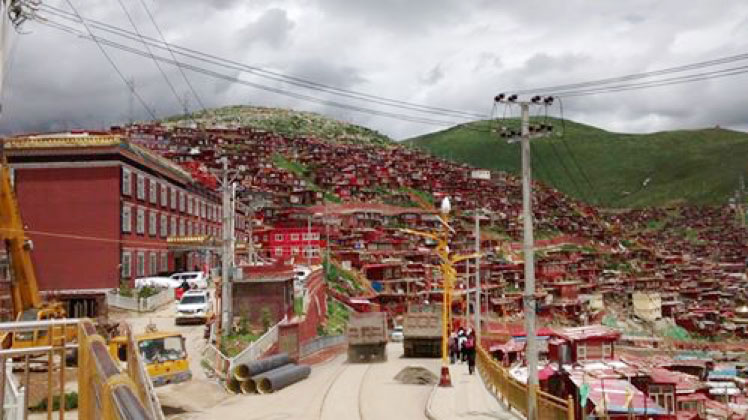
Larung Gar religious institute, summer, 2018; this image appears to show dump trucks used for construction, and other vehicles.
The following is a full translation of the official notice, which was published in Chinese and Tibetan:
Larung Monastery Management Committee
Serthar Five Sciences Buddhist Academy Management Committee
Serthar County Ethnic and Religious Affairs Bureau
Notice Regarding Larung Monastery Not Holding the 2018 “Dechen Shedrub Festival”
In order to further consolidate and promote the results of rectifying the preaching at key temples, in accordance with the newly-revised “Religious Affairs Ordinance” and the “Kardze Tibetan Autonomous Prefecture Method of Administering Religious Activities,” Larung Monastery will not hold the 2018 “Dechen Shedrub Festival.” Only resident monks may recite scriptures, and no monks or members of the masses of religious believers from outside the monastery and institute may be accepted. Township and town Party Committees and governments must do good ideological guidance work for the masses, and discourage local monks or members of the masses of religious believers from coming to Larung Monastery.
According to the central United Front Work Department, the Serthar County Larung Five Sciences Buddhist Institute as well as the Larung Monastery were separately both established with the approval of the National Religious Affairs Bureau as the “Serthar Five Sciences Buddhist Institute.” As the Serthar Five Sciences Buddhist Institute is one of Kardze Prefecture’s mid-level training centers for the Nyingma school of Tibetan Buddhism, responsible for Tibetan-language Buddhist instruction work, it is not a principal actor which can host any Buddhist activities. Any civil or online communications claiming that the “Serthar Five Sciences Buddhist Institute” is organizing any type of “Buddhist Festival” is untrue. It is kindly requested that townships and towns correctly guide the masses of monks and religious believers.
Hereby announced
[Seal of the Larung Monastery Management Committee]
[Seal of the Serthar Five Sciences Buddhist Academy Management Committee]
[Seal of the Serthar County Ethnic and Religious Affairs Bureau]
October 16, 2018
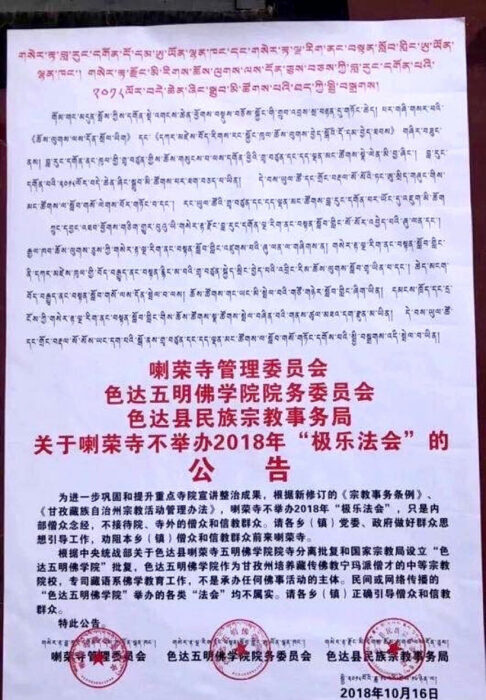
Footnotes:
[1] International Campaign for Tibet report, ‘China tightens screws on Tibetan Buddhism’, September 11, 2018, https://www.https://savetibet.org/china-tightens-screws-on-tibetan-buddhism/
[2] International Campaign for Tibet report, ‘Major religious festival cancelled and new police checkpoints at Larung Gar’, November 3, 2017, https://www.https://savetibet.org/major-religious-festival-cancelled-and-new-police-checkpoints-at-larung-gar/ A Tibetan who spoke to the Tibetan language service of Radio Free Asia in 2017 said: “The festival organizers had fully prepared for the event,” he said. “They sent people to Chengdu city to buy everything they would need, and the local people had excitedly begun to set up tents at the venue.” (Radio Free Asia, ‘China Bans Major Prayer Festival at Larung Gar’, November 1, 2017, http://www.rfa.org/english/news/tibet/prayer-11012017155249.html).
[3] Human Rights Watch, ‘China: New Controls on Tibetan Monastery: Religious, Education Authority Shifts to Party Cadres’, January 24, 2018, https://www.hrw.org/news/2018/01/24/china-new-controls-tibetan-monastery. Also see the report by the Tibetan Center for Human Rights and Democracy, ‘Tightening the Noose’, August 23, 2017, http://tchrd.org/tightening-the-noose-china-appoints-communist-party-members-to-key-positions-at-larung-gar-tibetan-buddhist-institute/

